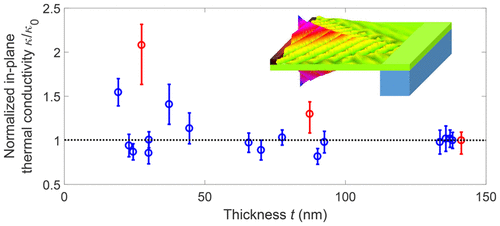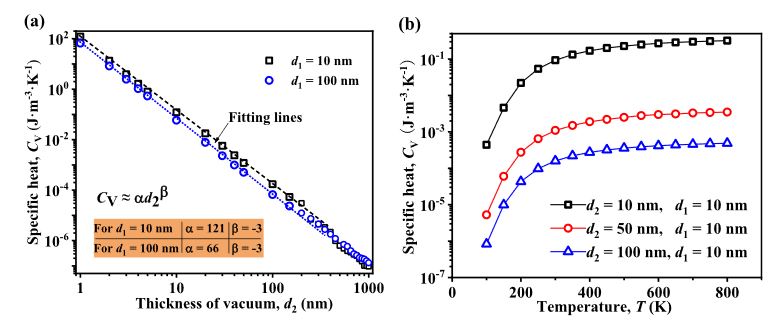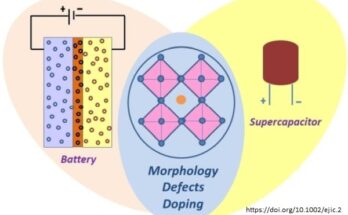Improving the heat dissipation of increasingly miniaturized microelectronic devices is a serious challenge. Studies discover that the thin film’s thermal conductivity of both electrons and phonons decreases when the thin film’s thickness scales down to nanometer regime because of dimension effect. The scaling effect in dimensions has in-depth engineering context, such as heat dissipation, reliability, and device lifespan. Theoretically, as the dimensions scale down, the high surface-to-volume ratio causes more frequent scattering of phonons on the surface of nanostructures significantly reduces heat conduction. However, if phonons combine with photons to form mixed surface quasi-particles, called surface phonon-polarons (SPhPs), then the surface may become an additional heat dissipation channel.
The high surface-to-volume ratio of nanomaterials enables the thermal transport to happen not only inside the volume but also along the interfaces. The interfacial thermal transport is driven by surface phonon polaritons (SPhPs) that enhance the in-plane thermal conductivity of suspended silica films as the thickness decreases to lower than 200nm. Laurent Tranchant et.al have experimentally shown this enhancement of thermal conductivity by surface phonon-polaritons (SPhPs). With this finding, new nanomaterials for better thermal management in miniaturized electronic devices can be engineered to provide heat transport at the nanoscale.

In the research work reported by Congliang Huang and Yingying Lan, the thermophysical properties induced by surface phonon polaritons (SPhPs) in multilayer systems were probed. The results show the polariton-induced specific heat is much smaller than that contributed by phonons due to the large difference of the density of states. The thermal conductivity along in-plane direction can be 1012 times larger than that along across-plane direction. This polarization of the thermal conductivities suggests a potential application of the multilayer systems for heat dissipation. Along with the enhancement of thermal conductivity by surface phonon polaritons, the expansion coefficiency caused by polaritons is several orders lower than that caused by phonons alone. This is an advantage of the surface phonon polariton (SPhP) method of heat transfer enhancement.

In another study, Dye-Zone A. Chen et.al calculated that a 40 nm thick film of a amorphous silicon dioxide (SiO2) has a total thermal conductivity of 4 W m-1K-1 at 500 K, which is an increase of about 100% over the intrinsic phonon thermal conductivity.

Recently, researchers such as Y. Wu & M. Nomura from the University of Tokyo in Japan have experimentally proved the formation of SPhPs on the surface of SiN nanofilms and the subsequent enhanced heat conduction. Please refer to the paper “Enhanced thermal conduction by surface phonon-polaritons” published on Science Advances on September 30, 2020.
Phonons are quasi-particles of lattice vibration and are the main hot carriers in dielectric materials. According to their dispersion relationship, phonons are called acoustic phonons or optical phonons. The contribution of optical phonons to heat conduction is generally considered to be negligible because of their lower group velocity compared to acoustic phonons. The thermal conductivity of a dielectric film is usually driven by acoustic phonons and decreases with the increase of the film thickness as the frequency of surface scattering events increases. In view of the miniaturization of devices with increasing operating rates, this reduction in thermal conductivity leads to overheating, low reliability, and shortened life of electronic components. However, although the thermal transport of acoustic phonons may be at its limit, the coupling of optical phonons and surface electromagnetic waves may enhance heat dissipation.
In the last decade, researchers have done intensive work on studying the surface waves because surface effects dominate the scaling effects in nanostructures that has very high surface-to-volume ratio. Certain types of surface electromagnetic waves can even carry heat, thereby improving the thermal performance and stability of nanodevices. Among all the surface waves, the surface phonon-polarons (SPhPs) is a mixed form of optical phonons and surface electromagnetic waves. SPhPs are essentially evanescent waves propagating along the surface of a polar dielectric film. SPhPs in nitrides, especially ultra-thin nitrides such as boron nitride, have been developed to guide infrared light for optical modulation and light detection. The propagation length of SPhPs is measured in the range of a few hundred microns, which is several orders of magnitude longer than a typical phonon mean free path. The theoretical model predicts that such a long propagation length enables SPhPs to conduct several times more heat energy than phonons when the film thickness is less than 100 nm. Recent SiO2 film experiments have provided some clues about the contribution of SPhP to heat transfer within a limited temperature range. The reported results are not completely conclusive, because the thickness and temperature dependence are almost indistinguishable from the corresponding results in volume of SiO2.
In this study, the researchers use different methods and focus on temperature changes over a wider temperature range, rather than thickness dependence. The essence of the researcher’s experiment is to measure the same sample at different temperatures. The measurement results show that when the temperature is from 300 to 800 K, the in-plane thermal conductivity of the film with a thickness of less than 50 nanometers doubles, while the thicker film shows a monotonous decrease. Theoretical analysis shows that the dependence of these thicknesses on temperature is an evidence of the contribution of SPhPs to heat conduction. In various fields including microelectronics and silicon photonics, the heat transport demonstrated by SPhPs can be used as a previously unidentified heat dissipation channel.



In summary, the researchers experimentally measured the in-plane thermal conductivity of amorphous SiN films at different temperatures. In the range of 300-800 K, when the film thickness is less than 100nm, the thermal conductivity increases significantly. The researchers attribute this enhancement to the spread of SPhPs along the membrane interface.
Reference
- https://www.jst.go.jp/pr/announce/20201001/index_e.html
- Tranchant, S. Hamamura, J. Ordonez-Miranda, T. Yabuki, A. Vega-Flick, F. Cervantes-Alvarez, J.J. Alvarado-Gil, S. Volz, K. Miyazaki, “Two-dimensional phonon polariton heat transport”, Nano Lett., 19 (2019), pp. 6924-6930
- Congliang Huang and Yingying Lan, “Thermophysical study of surface phonon polaritons in multilayer systems for heat dissipation”, International Journal of Thermal Sciences 159 (2021) 106548
- Dye-Zone A. Chen, Arvind Narayanaswamy and Gang Chen, “Ehancement of In-Plane Thermal Conductivity of Thin Film Via Surface Phonon-Polaritons”, Proceedings of IMECE2005, 2005 ASME International Mechanical Engineering Congress and Exposition, November 5-11, 2005, Orlando, Florida USA
- Wu, J. Ordonez-Miranda, S. Gluchko, R. Anufriev, D. De Sousa Meneses, L. Del Campo, S. Volz and M. Nomura, “Enhanced thermal conduction by surface phonon-polaritons”, Science Advances 30 Sep 2020, Vol. 6, no. 40, eabb4461
- Wu, J. Ordonez-Miranda, S. Gluchko, R. Anufriev, S. Volz and M. Nomura, “Surface phonon-polaritons enhance thermal conduction in SiN nanomembranes”, arXiv: Mesoscale and Nanoscale Physics, 2019
- Tachikawa, S.; Ordonez-Miranda, J.; Wu, Y.; Jalabert, L.; Anufriev, R.; Volz, S.; Nomura, M. High Surface Phonon-Polariton in-Plane Thermal Conductance along Coupled Films. Nanomaterials 2020, 10, 1383.




